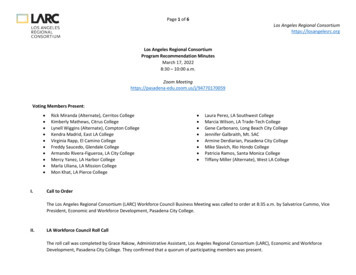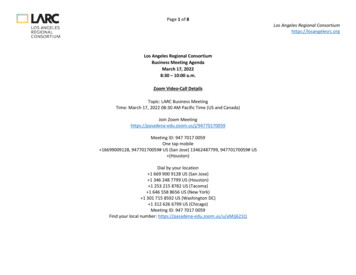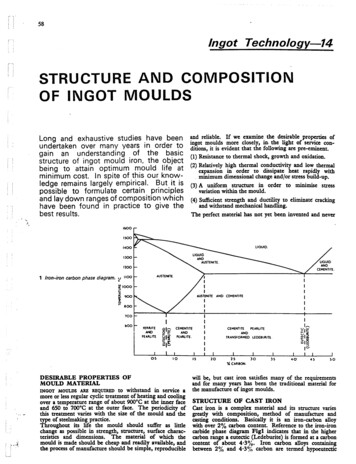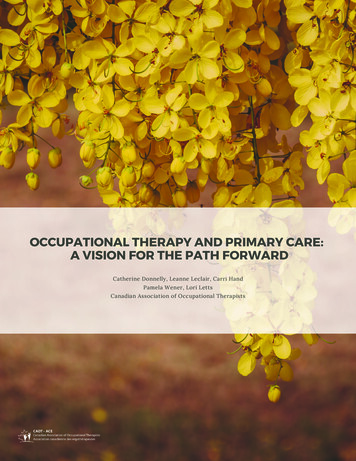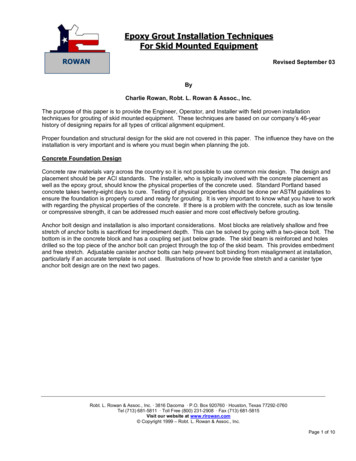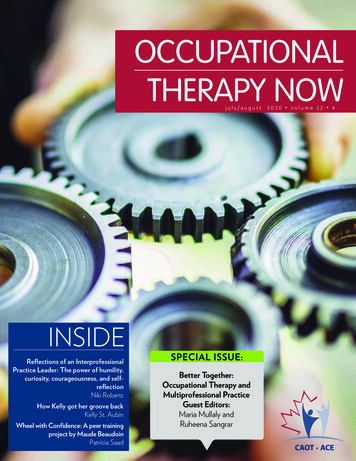
Transcription
july/augustINSIDEReflections of an InterprofessionalPractice Leader: The power of humility,curiosity, courageousness, and selfreflectionNiki RobertsHow Kelly got her groove backKelly St. AubinWheel with Confidence: A peer trainingproject by Maude BeaudoinPatricia SaadSPECIAL ISSUE:Better Together:Occupational Therapy andMultiprofessional PracticeGuest Editors:Maria Mullaly andRuheena Sangrar2020 volume 22 4
COVID-19OCCUPATIONAL THERAPISTS:ESSENTIAL TO MENTAL HEALTHTAKE ACTION NOW!Send a message to inform decision makers that OTs should be recognized as mental health providersand included in public and private health care plans.Despite the unprecedented disruption that COVID-19 has wreaked on everyday lives, most Canadianscannot access occupational therapy services as occupational therapy is not covered under most publicand private health care plans.Send this letter to your employer/union/insurance company asking for OT to be includedin your health plan.Download and share these COVID-19 mental health case studies:Family DisruptionReturning to WorkSocial IsolationWe’re all in this together. Occupational therapists are essential to mental health.www.caot.ca/mentalhealthOT
Table of ContentsBetter together: Advancing occupational therapy practice through alliance-building and collaborative learning. 3OCCUPATIONAL THERAPY RESPONSES TO THE GLOBAL PANDEMICOccupational gifts in the time of a pandemic. 5Hiba ZafranEngagement in living during the COVID-19 pandemic and ensuing occupational disruption.7Karen Whalley HammellKNOWLEDGE TO PRACTICEHow Kelly got her groove back.9Kelly St. AubinInterprofessional education in a community hospital: Discovery and opportunity.11Kim de Haan“Learning with, from and about each other”: Preparing OT students for interprofessional collaborative practice.14Cynthia Perlman & Liliane Asseraf-PasinSHARED PERSPECTIVESReflections of an Interprofessional Practice Leader: The power of humility, curiosity, courageousness, and self-reflection. 17Niki RobertsLearning side by side: Innovating interprofessional education by developing Faces of Healthcare.19Emily Tsing-yee Chai, Samantha Aparicio, & Sijia WangEmbracing Interprofessional Practice: Clients partnering with students. 21Sylvia Langlois, Jennifer Boyle, & Elizabeth CadavidIMPACTING LIVES, COMMUNITIES AND SYSTEMSFrom the Canadian occupational therapy community: In memoriam Ann A. Wilcock. 24Debbie Laliberte Rudman, Lynn Shaw and Liz TownsendUPDATES FROM THE COTFUpdate from the COTF. 26Wheel with Confidence: A peer training project by Maude Beaudoin.27Kathy FuchigamiBOOK REVIEWSOff to a good start: A behaviorally based model for teaching children with Down Syndrome.28The Aging–Disability Nexus. 29Cover photo credit: iStock/IAM-photographyISSN: 1481-5532Canada Post agreement #40034418
Statements made in contributions to Occupational Therapy Now(OT Now) are made solely on the responsibility of the author andunless so stated do not reflect the official position of the CanadianAssociation of Occupational Therapists (CAOT), and CAOTassumes no responsibility for such statements. OT Now encouragesdialogue on issues affecting occupational therapists and welcomesyour participation.ADVERTISINGTracy JoliffePhone: (613) 523-2268, ext. 241Email: advertising@caot.caEditorial rights reservedAcceptance of advertisements does not imply endorsement by OTNow nor by CAOT.SUBSCRIPTIONSPhone: (800) 434-2268, ext. 221Email: subscriptions@caot.caCAOT PRESIDENTCatherine Backman, PhD, Reg. OT (BC), FCAOTCOPYRIGHTCopyright of OT Now is held by CAOT. Permission must beobtained in writing from CAOT to photocopy, reproduce or reprintany material published in the magazine unless otherwise noted.There is a per page, per table or figure charge for commercial use.CAOT or ACOTUP members have permission to share copiesof an article if such copies are distributed without charge foreducational or consumer information purposes.CAOT CHIEF EXECUTIVE OFFICERHélène Sabourin, RN, MHARETURN UNDELIVERABLECANADIAN ADDRESSES TO:Canadian Association of Occupational Therapists100-34 Colonnade RoadOttawa, Ontario K2E 7J6 CanadaEmail: publications@caot.caOccupational Therapy Now is published six times a year (bimonthlybeginning with January) by the Canadian Association of OccupationalTherapists.MANAGING EDITORNaomi Hazlett, OT Reg. (Ont.)Tel. (613) 523-2268 ext. 243Email: otnoweditor@caot.caSense of DoingKatie Lee Bunting, MScOT, Reg. OT (BC)E-Health and In Touch with Assistive TechnologyLaura Kalef, OTMegan M. MacPherson, OTEveryday StoriesÉmilie Simoneau, BSc. OT Reg. (Ont.)COPY EDITINGClaire Hurd, MScOT, OT Reg. (Ont.)Letitia Henville, PhDPriscilia Bolanos (English)Alexa Gravel (French)Vicki Piché, Erg. Aut. (Ont.) (French)OT NOW EDITORIAL BOARDChair: Naomi Hazlett, OT Reg. (Ont.)Patricia Dickson, MSc, OT Reg. (Ont.)Jeff Boniface, M.Sc., Reg. OT(BC)Mercerina Lychek, OT Reg. (Ont.)Juan Lopez, OT Reg. (Ont.)Maria Mullally, B.Sc. Hon., M.Sc.OT, OT Reg (NS)Hiba Zafran, PhD, erg., occupational therapist-psychotherapistKathryn Wise, OTD, MHSc, OT Reg. (Ont)ex-officio: Catherine Vallée, Editor in Chief, CJOTex-officio: Julie Lapointe, erg., OT Reg. (Ont.), PhDTOPIC EDITORSIndigenous Peoples & Occupational Therapy in CanadaLaura Giroux, MScOTTara White, M.Sc, O.T. Reg(NS)International ConnectionsAndrew Freeman, PhD, erg.OT ThenHadassah Rais, MSc (OT–Post-Professional), OT Reg. (Ont.)Elizabeth Pooley, OT Reg. (Ont.)Private Practice InsightsNicola Schaan, Reg O.T. (BC)Copyright requests may be sent to:copyright@caot.caKT & OTMercerina Lychek, OT Reg. (Ont.)Keiko Shikako-Thomas, PhD, OTDESIGN & LAYOUTJAR Creative2INDEXINGOT Now is indexed by ProQuest and OTDBase.Enhancing PracticeOlder Adults: Ben Mortenson, PhD, OTAdults: Bice Amoroso, MSc, OT Reg. (Ont.) and Alexandra Lecours, OT, PhDChildren and Youth: Patricia O’Krafka, MSc, OTMental Health: Hiba Zafran, PhD, erg., occupationaltherapist-psychotherapist, Samantha Oostlander, OT Reg. (Ont.), PhDStudentRural and Remote Practice: Niki Kiepek, PhD, OT Reg.(NS)Student PerspectivesKatharine Fuchigami, MSc. Health and Rehabilitation Sciences, BHSc.Alanna Veitch, Dipl. OTA&PTACJOT: Evidence for your practiceLori Letts, PhD, OT Reg. (Ont.), FCAOTJackie Bosch, PhD, OT Reg. (Ont.)Fieldwork and EducationAnne W. Hunt, PhD, OT Reg (Ont)Catherine White, PhD, OT Reg. (NB, NS)Practice Management and Professional SkillsLeslie-Ann Stewart, OT Reg. (Ont.)Occupational Therapist Assistants and Support PersonnelErin Moerman, OTA & PTAAll OT Now Editorial Board members and topic editors are CAOTmembers in good standing.OCCUPATIONAL THERAPY NOW VOLUME 22.4
EditorialEditorial: Better together—Advancing occupational therapypractice through alliance-building and collaborative learningRuheena Sangrar & Maria MullallyWelcome to the July 2020 special issue of OccupationalTherapy Now. As the guest editors, our interest in thisissue stems from our own experiences of success and growthon multi-professional teams. We consider these opportunitiesto be significant and meaningful to our professionalidentities. Between us, we have been part of interprofessionalteams in clinical settings, and also are currently involved ininterprofessional education and interdisciplinary research.Through our careers, we have partnered with healthcareprofessionals and non-traditional partners. These individualsinclude life-skills counsellors, people with disabilities,equipment vendors, administrators, policymakers, and drivinginstructors, to name a few. With each collaboration, we cometo better understand the importance of optimizing our abilityto work together.We never could have anticipated the circumstancesin which we would be writing this editorial; COVID-19 iscurrently responsible for a global pandemic and a nationwidestate of emergency. Our health system is becoming strainedbeyond its capacity, and in some contexts, occupationaltherapy services have been deemed non-essential or havebeen transferred to virtual platforms. Our peers in healthcare, seniors care, and social services brave the front linesand continue to treat the most vulnerable members of ourpopulation. We have all had our daily routines disrupted; we’vebeen re-deployed within our organizations to new practicesettings, challenged to rebalance our personal and professionalroles, all the while struggling to maintain a sense of stabilitygiven an uncertain future.What do we do when we are faced with such a hugeproblem, such significant change, and so much uncertainty?Whalley Hammell (p. 7) and Zafran (p. 5) raise theimportance of using coping strategies following experiencesof occupational disruption. They urge us to consider howwe can extend our clinical expertise to manage thesecircumstances. But how might we pool our efforts with othersto support those in our society who are experiencing any formof marginalization or injustice? For them, the impact of thispandemic is amplified, leading to a greater risk of worsenedhealth outcomes, social isolation, and economic instability. Asoccupational therapists, we are uniquely positioned to reducethe effect of this crisis by coping collaboratively with others.A word on wordsWe use the phrase “multi-professional practice” to referto all forms of interprofessional, interdisciplinary, andmultidisciplinary partnerships, in hopes of capturing all theways occupational therapists work alongside colleagues inacademic, practice, and research settings. In this issue, wedeferred to each contributing author to define the terms theyopted to use given their unique contexts and collaborators.Beyond terminology, many contributors also describe thepersonal meanings they attached to these partnerships and theperceived value in building alliances and learning with others.Where occupational therapists excelAs occupational therapists, our ability to see the big picture isdescribed by St. Aubin (p. 9) and Roberts (p. 17) through theirexperiences of leadership in new roles within their respectivepractice contexts. Our ability to extend the boundaries of ourpractice, to take on non-traditional roles, such as on ethicscommittees and as interprofessional practice leads, optimallypositions us to guide our colleagues in complex situations(Shams, Batth, & Duncan, 2019). For example, de Haan (p. 11)shares her experience of a rare opportunity to lead practiceprocess change in a new clinical team, with the tangibleoutcome of improving client care.Another predominant theme in this issue is the occupationaltherapy role in shaping interprofessional education (IPE) forstudents and experienced clinicians. With a growing evidencebase (Boshoff et al., 2020), IPE is an integral componentof academic curricula in all Canadian occupational therapyeducation programs. Several authors describe structuredapproaches to delivering IPE in university programs as well ascontinuing education within clinical settings. Some introducethe Canadian Interprofessional Health Collaborative’s(CIHC) National Interprofessional Competency Framework(2010) to outline key competency domains targeted by IPE.Langlois, Boyle, and Cadavid (p. 21) and Perlman and AsserafPasin (p. 14) describe how competency-based IPE can beintegrated across health disciplines in a university setting,with Langlois and colleagues also highlighting the importantrole of patient partners. Chai, Aparicio, and Wang (p. 19)provide the student perspective of innovating interprofessionallearning opportunities for themselves and their peers inmedicine. De Haan (p. 11) also describes a step-by-stepapproach to developing both a shared language and a sharedunderstanding of clinical roles and responsibilities.As a whole, these articles showcase occupational therapistsand students taking on progressive roles and advocatingfor relationship-building with colleagues and clients. Theseexamples highlight not only their ability, but more importantly,OCCUPATIONAL THERAPY NOW VOLUME 22.43
their willingness to learn “about, from, and with each other”(World Health Organization, 2010, p. 7). The CIHC (2010)has highlighted the importance of collaborative leadershipand other competencies for health professionals, as well as theimportance of integrating skill development in professionaleducation programs. The writers in this issue of OccupationalTherapy Now provide us with clear illustrations of reflectivepractice as they navigate barriers, challenges, and change—we hope their stories will inspire students, academics, andpractitioners alike.Charting the way forwardWhile acknowledging the diversity of articles in this issue,there are gaps as well. Many of our submissions are fromsimilar geographical and practice contexts, which do notprovide a pan-Canadian representation of complex regionalhealth care and social service realities. We also challenge ourreaders to reflect on who else they might consider partneringwith outside of the health care bubble, with the ultimate aimof improving client-centered care. For example, what storiescan we tell about our relationships with administrators, expertsin business, finance, and legal disciplines, as well as engineers,innovators, and designers? How can we expand on clientinvolvement in creative ways?The current pandemic has prompted reflection on theboundaries of our current roles and the opportunities availableto refine and extend our areas of expertise into non-traditionaldomains of practice. We are grateful for the contributions ofall the authors and each unique perspective. We believe thatthese articles portray examples of how occupational therapistsare well positioned to take on new roles as leaders andeducators on multi-professional teams now and as we moveinto the uncharted territory of a future that needs collaborativeleadership more than ever. Perhaps these articles will provideyou with additional information and inspiration to expand yourown thinking and practice, whatever the future holds.References:Boshoff, K., Murray, C., Worley, A., & Berndt, A. (2020). Interprofessionaleducation placements in allied health: A scoping review, ScandinavianJournal of Occupational Therapy, 27(2), 80-97. ian Interprofessional Health Collaborative (CIHC) (2010). A nationalinterprofessional competency framework. ational-Framework.pdfShams, S., Batth, R., & Duncan, A. (2019). The lived experiences ofoccupational therapists in transitioning to leadership roles. The OpenJournal of Occupational Therapy, 7(1). https://doi.org/10.15453/21686408.1513World Health Organization (WHO). (2010). Framework for action oninterprofessional education and collaborative practice. http://www.who.int/hrh/resources/framework action/en/About the authorsMaria Mullally, MScOT, OT Reg. (NS), is a Nova Scotian occupational therapist who studied occupational therapy atMcMaster University, practiced for years at The Ottawa Hospital, and now lives in Halifax, where she is an associate withCornerstone Occupational Therapy Consultants and a tutor in the School of Occupational Therapy at Dalhousie University.She can be reached at: mariamullally@gmail.comRuheena Sangrar, PhD, OT Reg. (Ont.), completed her clinical and graduate training in Ontario at the University of Torontoand at McMaster University. She is currently an educator at both institutions. Her interests include interdisciplinary research,education, and practice, as well as optimizing function and occupational engagement in older adulthood. She can be reached at:4OCCUPATIONAL THERAPY NOW VOLUME 22.4
Occupational Therapy Responses to the Global PandemicOccupational gifts in the time of a pandemicHiba ZafranAs the world adapts to shifting priorities in new ways,health care workers are described in the media as beingon the frontlines of a battle, families are cut off from eachother by closed airports, economic challenges are present fortoo many, and the marginalized are at risk of becoming evenmore so. In spite of creative adaptation, scientific problemsolving, and the benefits of an eventual, more sustainable“new normal” in which environmentalism, economic priorities,and health care structures are reconsidered, awareness of theglobal phenomenon of a pandemic can generate challengesto maintaining our mental health. Occupational therapyoffers its own perspective on resilient being and doing as wetransitioned into restricted social and work environments—while acknowledging that the ability to choose to distance andself-isolate is a privilege.After decades of research on resilience, a metareview ofthe evidence concluded that “resilience rests, fundamentally,on relationships” with self, others, and the world writ large(Luthar, 2006, p. 780). Moving past a focus on geneticstudies, individual behaviours and skills, and complex systemicstatistical analyses, fourth wave resiliency research highlightsthe relational experiences of spirituality and communitybuilding in peoples’ abilities to survive and thrive (Richardson,2016). Rachel Thibeault is an occupational therapist whoserich career has focused on community-based rehabilitationinitiatives with the World Health Organization in post-conflictzones, as well as with refugees and Indigenous communities inCanada. She received the Order of Canada in 2012. Drawingon her work with “unsung heroes,” Rachel coined the term“occupational gifts” to describe those meaningful activities thatspecifically foster resilience, spirituality, hope, and belonging inchallenging situations (Thibeault, 2011). Here, I will introducethese five specific types of occupations and apply Rachel’sideas to the current experience of physical distancing. Whichof these types of activities are running short in your livesduring this time of transition and adaptation? Do you livealone or are you now constantly sharing space with others?Which type of activities do you need the most?Connecting occupations are those in which we experiencebelonging to others and to life. Sustaining connection iscertainly what is at the forefront of many minds: how to remainauthentically connected to loved ones when everything shiftsonline, beyond seeing and being seen. Some take a friendon a walk by talking on the phone with headphones. Virtualgroup coffee and martini hours have sprung up. Multipleactivity-based communities have moved online. Membersof families spread across countries already know the value ofparking a phone with a video chat enabled on a surface whileboth parties are engaged in a household activity, side by side.Yet, we can think of connection in broader ways, such as ourinterconnectedness with nature as we cuddle pets or say helloto the first signs of spring. There can be connection to ourneighbours as we (safely) chat over balcony railings whenthe weather warms up. We are more connected globally thansome may have initially thought. Whom or what are you lessconnected to that matters to you?Centring occupations foster presence, awareness, andcalm. Meditation walks in nature are a classic example.However, any repetitive type of activity such as knitting,folding laundry, jogging, grooming a pet, or doing gentleyoga cycles of sun salutations focused on the breath canfoster calm. Some may now be living constantly with family orroommates—do you get time and space to centre and connectto yourself? Attention to the sensory or ecological dimensionthat allows us to be present in the moment is an additionalelement in centring activities. What does the activity look like?Smell like? Feel like? Sound like? One can engage in low-lightcooking with gentle jazz music playing, attending to the scentsand flavors, or push furniture out of the way to create morephysical space to dance to favorite music in the dark. Whatcentres each of us can be quite unique and different. Whichactivities help you to feel calm and receptive?Creative occupations meet the human need to explore,play, and create without judgment. All those with children athome may have their fill of finger paint, and [c]hildren may have their real small-scale disasters, butadults have their very own large ones: war, catastrophe,accidents, hurricanes, riots, sickness, and death. .Theunreal worlds of play.are about how to react emotionallyto the experience of living in the world and how totemporarily vivify that experience by transcending its usuallimits. (Sutton-Smith, 1997, p. 162, 159)We all could do with writing a silly sonnet, drawing an alleycat, or singing a superstar song. Maybe now is a good timeto learn a new skill, like a signed language, attend to a homeproject that has been languishing, or make handcrafted giftsfor others and send them by mail. “Pantry cooking” involvescombining foods from the back of your shelves or bottomof your freezer in novel and nutritious ways. For many of us,finding new tools and ways to teach and do research remotelycan be experienced as creativity. Are you taking the time tocreate in ways that draw on your imagination and that youenjoy?Contemplative occupations are those that induce awe oflife. Unlike centring, which grounds us in our bodies and theOCCUPATIONAL THERAPY NOW VOLUME 22.45
present, contemplation fosters perspective taking, pulling usout of ourselves toward the (much) bigger picture of whatothers (now and in past and future generations) and the planetmay be experiencing, as well as how all have the capacity toadapt and evolve. One might also simply contemplate a basilplant on a sunny windowsill. The art of contemplation canbe challenging, as the noise of the outside quiets beyond theonline world, which can leave much psychic space for anxietyand worries to arise. Journaling, praying, taking long walks innature, doing yin yoga that favours postures in which you thankthe earth for holding you up, listening to specific types ofmusic (for me its solo cello pieces), reading beautiful literatureand novels, visiting a museum online, or simply allowingyourself the time for morning stares hanging onto your coffeemug can all foster contemplation. What do you do that allowsyou to ponder the enormity of it all with quietude?Contributing occupations allow us to give back within thecommunities that hold us up. Researchers are reaching outto partners to see how projects can be turned around to bemore immediately useful, local students are checking in withtheir international peers, and therapists are forming onlinecollectives to support frontline workers. This is all wonderfulto see and experience. In my neighbourhood, almost everyhome with a child suddenly has a painting of a rainbow in thewindow, to signal brighter days ahead. People are reachingout to elderly neighbours down the hall and offering to dropoff groceries at their front doors, spring cleaning and thensharing extra resources with others less fortunate, setting upvirtual ways for grandparents to be involved in homeschoolingor storytime, creating a telephone tree for emergencies,circulating an informational newsletter of resources, ordonating a skill to a community organization challenged tocare for its service users. Health care and humanitarian aidworkers are risking a lot for all of us. And, many groups will bemade more vulnerable, more isolated. What do you do to be avalued member of a community?These “5 Cs” of occupation help us reflect on the qualityof what we do and why we do it. I would add a sixth C—culture(s), and the richness each of us can draw on in relationto the above five essential types of activities, such as culturalrituals and ceremonies, traditional arts and crafts, comfortingfamily recipes and games, folk songs, novels and movies inyour native tongue, stories of resilience, and communitiesto which you are connected. Beyond all the things wehave to figure out how to do in different ways in curtailedenvironments, which values and actions will each of uschoose to enact in this time of change in order to (re)engagein meaningful activities that can foster our resilience, andtherefore our collective ability to sustain ourselves and those inneed, in the times ahead?ReferencesLuthar, S. S. (2006). Resilience in development: A synthesis of researchacross five decades. In D. Cicchetti & D. J. Cohen (Eds.), Developmentalpsychopathology: Risk, disorder, and adaptation (pp. 739-795). John Wiley &Sons Inc.Richardson, G. E. (2016). Chapter 11: The applied metatheory of resilienceand resiliency. In U. Kumar (Ed.), The Routledge international handbook ofpsychosocial resilience. Taylor & Francis.Sutton-Smith, B. (1997). The ambiguity of play. Harvard University Press.Thibeault, R. (2011). Chapter 10: Occupational gifts. In M. A. McColl (Ed.),Spirituality and Occupational Therapy (2nd ed., pp. 111-120). CAOTPublications ACE.About the authorHiba Zafran, PhD, is an occupational therapist-psychotherapist, assistant professor, and poet. She can be reached at: www.mcgill.ca/spot/hiba-zafranErrata1. With reference to the following article:Zafran, H., Barudin, J., Saunders, S., & Kasperski, J. (2019). An occupational therapy program lays a foundation for Indigenous partnerships and topics.Occupational therapy Now, 2194), 28-29. [Special Issue. Time for Action: Occupational therapy responses to the Truth and Reconciliation s%20partnerships.pdfThe purpose and process in producing the evidence-informed document that is summarized in the article was to build the knowledge andcapacity of McGill University’s Occupational Therapy program in finding an ethical and wise path to respond to the Truth and ReconciliationCommission’s Calls to Action and the United Nations Declaration on the Rights of Indigenous Peoples. In line with the ethos of collectiveknowledge, the complete report is now available for consultation, dialogue and referencing. It is openly accessible here: 0r997?locale enContact: hiba.zafran@mcgill.ca2. The correct website information for the photographer of the cover of May 2020’s issue of Occupational Therapy Now is as m6OCCUPATIONAL THERAPY NOW VOLUME 22.4
Occupational Therapy Responses to the Global PandemicEngagement in living during the COVID-19 pandemic andensuing occupational disruptionKaren Whalley HammellMeasures being taken to slow the spread of theCOVID-19 virus have disrupted the lives of countlessmillions of people around the world. For many of us, life“before” seemed seductively predictable, our diaries full of theappointments, commitments, events, and trips that constitutedan envisioned future. And then everything changed.For the many people who share with me the experienceof social privilege that accompanies our class, educational,professional, cis-gendered, and “able” statuses, it has beenfrustrating to endure, albeit temporarily, the sort of deprivationof occupational opportunities usually reserved for disabledpeople and others marginalized and disempowered by poverty,racism, and the legacies of colonialism—people for whom lifeis consistently unpredictable and fraught with uncertainty.Now, much of the population is sharing a fear of financialuncertainty and concerns about obtaining food and othernecessities. Experiences that have constituted everyday life formany of those on the margins are now shared by the majoritypopulation: the lack of opportunity to access educational andemployment settings; the inability to access buildings, libraries,public spaces, as well as arts, cultural, social, recreational, andother public resources; and the loss of opportunity to movefreely within our own communities or around the world. Theseconstraints on the abilities and freedoms many formerlyviewed as rights and entitlements—and fear of the virus itself—have left intense feelings of anxiety and uncertainty.Fortunately, as occupational therapists, we already possessthe knowledge required to fully engage in life despite thecurrent, formidable challenges. We have had the opportunityto learn from the experiences of so many clients whoseseemingly predictable lives—and the mundane, taken-forgranted expectations, plans, and routines that had structuredthose lives—have been disrupted by factors beyond theircontrol, such as serious injury or i
Occupational Therapy and . Multiprofessional Practice Guest Editors: Maria Mullaly and . Ruheena Sangrar. COVID-19. OCCUPATIONAL THERAPISTS: . (2010) to outline key competency domains targeted by IPE. Langlois, Boyle, and Cadavid (p. 21) and Perlman and Asseraf-Pasin (p. 14) describe how competency-based IPE can be
